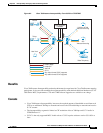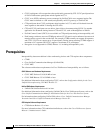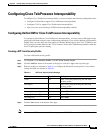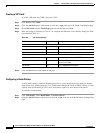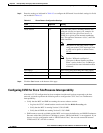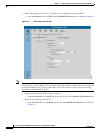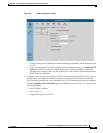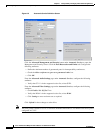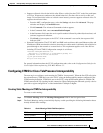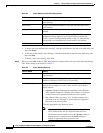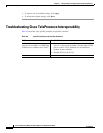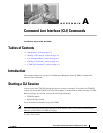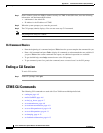
8-85
Cisco TelePresence Multipoint Switch Release 1.1 Administration Guide
OL-12586-02
Chapter 8 Interoperability with Legacy Video Conferencing Devices
Configuring Cisco TelePresence Interoperability
• Suppress reflected video for the initial caller. When a caller joins the CUVC as the first participant
of a Cisco Telepresence conference, the default behavior is for that caller to see his or her own
image. To have that initial caller see a black screen instead, you must suppress reflected video. To
suppress the reflected video:
–
From the MCU configuration page, select the Settings tab, then click Advanced. The page
refreshes and displays a Command button.
–
Click Commands. The Advanced Commands window appears.
–
In the Commands field, enter: mc:notselfseeforfirstpart
–
In the Parameter field, enter the service prefix number followed by either 0 (to deactivate) or 1
(activate) suppressed reflection.
–
Click Send to issue request to the CUVC. If the command is successful, the response field
indicates “OK.”
• Network Configuration: The CUVC MCU and EMP cards each have their own Ethernet cables and
IP addresses. Make sure that the switch to where the two cables attach is defined to allow QoS to be
passed through to the network as a trusted device. This requirement applies to all video devices
including CTS and CTMS. Configuration example is as follows:
interface TenGigabitEthernet 4/2
description ===connection to telepresence gateway 2===
ip address 10.xx.xx.xx 255.255.255.252
ip pim sparse-dense-mode
mls qos trust dscp end
For general information about the CUVC configuration tasks, refer to the Configuration Guide for the
Cisco Unified Videoconferencing 3545 MCU Release 5.5.
Configuring CTMS for Cisco TelePresence Interoperability
The next step is to configure a static meeting in CTMS in “interop mode.” When the first CTS caller joins
the teleconference, CTMS dials out to the CUVC using the Interoperability number configured in the
CTMS meeting definition. CTMS dials out to the CUVC using the SIP trunk defined in Unified CM.
CTMS cannot use H.323 signaling for this connection. When configuring the SIP trunk, specify a device
pool with a region configured for a video bandwidth of 768 kpbs or higher.
Creating Static Meetings in CTMS for Interoperability
To create a static meeting:
Step 1 Click Static Meetings under the Meetings Management folder in the Navigation Pane.
Step 2 The Static Meetings setting screen initially displays a table providing the following information about
already defined static meetings.
Table 8-4 Static Meetings Table Field Descriptions
Field Description
Access Number Displays the access number that rooms call to attend this meeting.
Description Displays the defined description for this static meeting.



